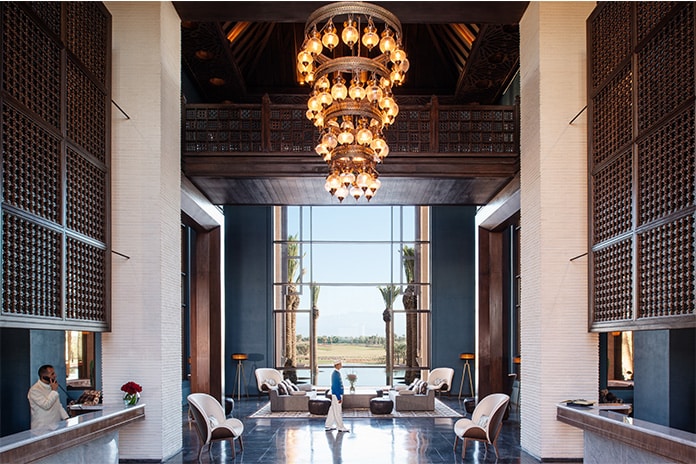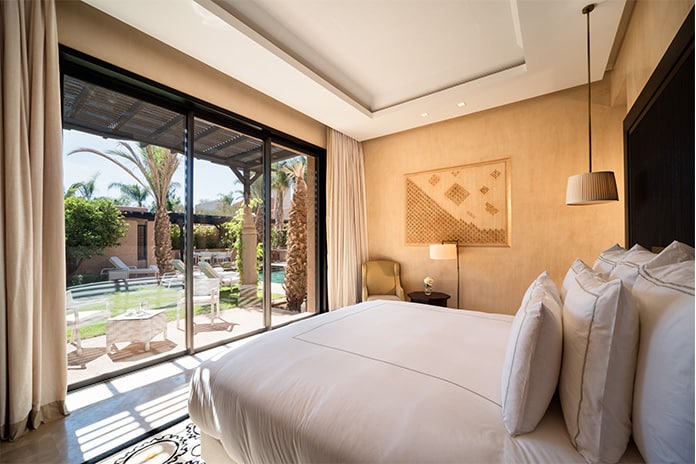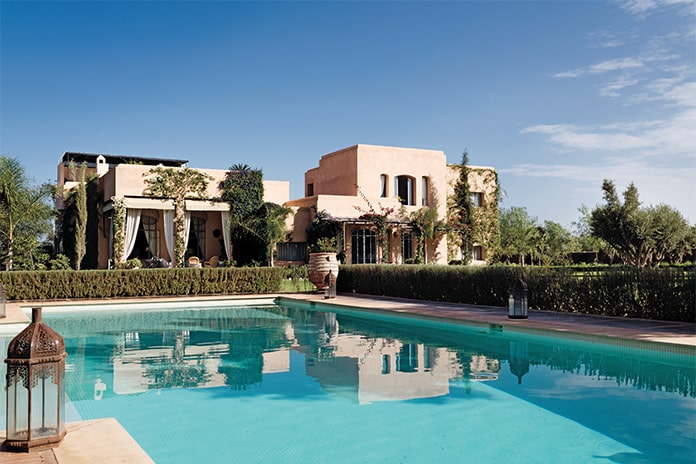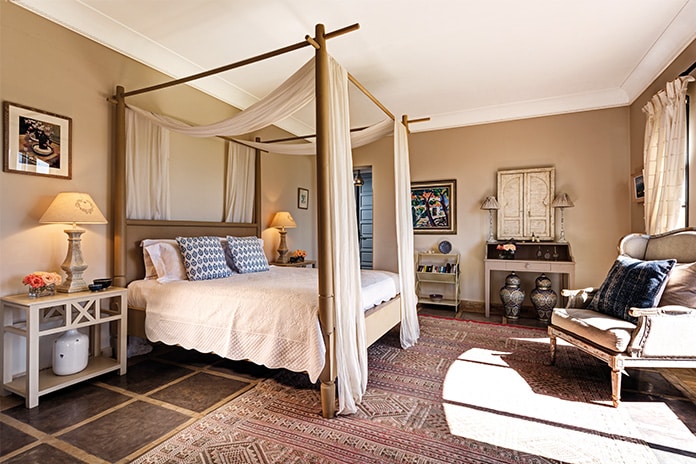Mama discovers two different and desirably indulgent family destinations on the fringes of the Moroccan capital
Words Helen Baron
The famous orange light of Morocco is nowhere to be seen as we step off the plane in Menara Airport, Marrakech. It is just barely spring in the much-mythologised North African kingdom, yet the weather is already – to a British visitor – summer-hot and summer-dry.
The light is white and dazzling, the sky a cloudless blue gently paled by dust blown in from the high Sahara. But whatever winds are troubling the firmament leave little trace below: we descend the aircraft steps in a sublime stillness of pure heat.
This is why we have come, for the most part: light, heat, sun. Tired of waiting for Britain’s dreary spring to brighten up its act, yet unwilling to fly for more than a few hours with two young children in tow, we cast about for reachable destinations that could give us what we needed: a first few hazy hints of summer.
Much Googling followed, as we compared long-range forecasts and almanacs of weather in springtimes past. Mainland Europe and the Mediterranean looked to be too unreliable, while Cape Verde – comfortingly hot even that early in the year – couldn’t supply a sufficiently exciting place to stay. Marrakech – a 3.5 hour flight from London, with spring temperatures in the mid-20s and a plethora of riads, hotels and villas to choose from – won almost by default.
So we booked, and we flew, and shortly afterwards we found ourselves checking in at our first destination: the Fairmont Royal Palm, Marrakech.

Located 12km from the Red City’s famous medina, the Fairmont is a palace in both aspect and amenity. The long, low main building sits amid 231 hectares of gardens and golf course, all slender palms and lush fountain grass, and is built in the impossibly elegant Moroccan style with abundant French colonial touches. It houses everything from a cathedral-like lobby (with towering gallery windows overlooking the estate) and stylish cocktail-cum-sushi bar to traditional French and Moroccan restaurants.
The many rooms and suites are mostly situated in smaller buildings of a similar style, ember-red and flame-orange in colour, ranged alongside and between the hotel’s other world-class facilities – a fully-equipped gym and sports centre, popular kids’ club and exquisite spa.
The gardens are carpeted with pink flowers and woven with paths perfect for evening strolls, while golf buggies are on hand to ferry guests to and from different parts of the hotel as required – handy when a weary three-year-old refuses to walk back to your suite at the end of a long day splashing about in the swimming pool.
The pool! It deserves a special mention. Seemingly half a mile long, criss-crossed by bridges of sun-bleached wood, surrounded on all sides by strings of well-attended loungers and delicate plantings, it’s as much a masterly visual flourish as a leisure resource. It’s also heated to 25-30°C – relatively rare in Morocco, and almost unheard of in the shaded riads of the Marrkech medina – which makes it ideal for younger children. You can swim (or wade – it’s not too deep) from the separate paddling pool at one end of the gardens to the café terrace at the other, taking in the sights as you go. And we did so – for two entire days. Our daughters took great delight in exploring the gardens by water, and we took delight in the lengthy naps they took thereafter, shaded from the afternoon sun by the spreading parasols while we ordered lunch directly to our loungers. With such luxurious facilities out of doors, you’d be forgiven for thinking we wouldn’t see much of our room – but, in fact, it became a sort of refuge in the evenings, especially when the little ones were too tired for us to trust their moods in the hotel’s restaurants.

Our family suite was huge, with a bath as large as most bathrooms, a walk-in shower that could easily hold six people, a walk-in wardrobe even larger, plus a spacious bedroom, private sitting room and two separate (but linked) terraces. It also came with every bit of baby kit you could wish for, from a bottle-warmer and steriliser to potties and baby baths.
Even better, each day a friendly member of staff would trill “Bonjour!” outside our door before bringing in a tray of treats for the kids – a vital extra service when the snacks you brought with you were all devoured on the flight. The chocolate-trimmed waffle cone filled with chopped fruit proved particularly popular.
We dined in our room one night and at the Moroccan Al Aïn restaurant the next; the latter is an essential experience, with beautiful Berber-themed dishes accompanied by traditional songs from local musicians. The maître d’ would occasionally join in on her favourite tunes as she showed new arrivals to their tables and greeted returning guests like old friends. Our youngest, meanwhile, stood mesmerised in front of the players as the sun dipped and the dusty skies turned rose and red and orange at the horizon. And suddenly, there it was: the orange light of Morocco, in full effect.
It was a fitting tribute to the Fairmont’s crowning achievement, which is the reframing of traditional Moroccan culture and style in an incredibly luxurious setting. It’s also a great reflection of the hotel’s suitability for families – its scale, amenities and impeccable service mean you can take the kids without worrying they’ll have an undue impact on other guests. In fact, a good half of our fellow visitors had children with them, and many seemed to take advantage of the kids’ club, which is open from morning to night (11pm!) and offers dedicated babysitters as well as a programme of activities.
By the end of our short trip, we’d had our eyes opened to the singular seductiveness of Morocco. Thus inspired, we continued to our next stop…
Rates for a Deluxe Room at the Fairmont Royal Palm start at £220 per night.

Gateway to the Atlas
It’s a straight road from Marrakech to the foothills of the High Atlas, the mountain range that bisects Morocco’s heartlands. As we leave the capital and drive towards the Ourika Valley, the blazing sun of our first few days gives way to more typical springtime weather: warm, breezy, skies fleet with cloud.
We are headed for Bab Adrar, a private estate set beside the main road just over halfway between the mountains and the metropolis – home to a collection of luxurious villas created by a British property developer and his designer wife, in concert with one of Morocco’s best-regarded architects.
The estate, when we reach it, could not be more discreet. Our driver turns off the tarmac and onto a narrow track marked by a single signpost. We pass fields of sheep and scrub grass before arriving at a high-walled compound with imposing wooden gates. A guard waves us through with a smile.
And suddenly we’re in something close to paradise.
The villas of Bab Adrar are strung along a single drive. Their walls, overhung with flowering bougainvillea, footed with cactus and more of that dusky fountain grass, add to the privacy. Our destination is Dar Zitouna, situated at the far end of the estate, with a sweeping gravel driveway that offers a tantalising first look at the house – all rich orange plaster and monolithic Moroccan geometry – and its encircling gardens.

Waiting for us at the door are the staff who will look after us during our stay: Nadia, our housekeeper; Zaira, our cook; and Aisha, our maid. They glow with welcome, fussing over the children and making us feel instantly at home. This is one of the great strengths of Dar Zitouna: it offers the privacy, flexibility and space of your own private villa with few of the associated responsibilities. No cleaning, no making beds, no shopping for food at local supermarkets and sweating over a hot stove. The staff live on-site and are on-hand to help with anything. The house manager, Mustapha, is similarly friendly and only ever a WhatsApp message away – he handled all our requests, from booking taxis and transfers to printing boarding passes for the flight home, and did so with maximum courtesy and efficiency. Which left us to enjoy the house and its gardens to the full.
The house has five beautiful bedrooms equipped with the plushest, comfiest beds, large bathrooms with walk-in showers and plenty of space for kids to play. The décor is homely but very high-end, styled for tasteful luxury with plentiful nods to Morocco’s history and traditions. Yves Saint Laurent lithographs and photos of the Rolling Stones in Marrakech adorn the walls, while Berber rugs warm the stone floors. There are fireplaces in the reception rooms – lit each evening during our stay for cosiness – and most of the bedrooms feature French doors opening onto garden terraces. A traditional central courtyard offers a peaceful space alive with the sound of running water from a wall fountain; from here, steps lead up to a large roof terrace where both covered and open sitting areas command astonishing views across open countryside and the High Atlas beyond.
The garden, meanwhile, is huge, a perfect lawn surrounded by rock gardens and decorative planting, through which run gravel paths scented by spring blooms and herb borders. A pétanque pit and pergola sit at the far end beneath three immense palms, while off to one side is the swimming pool – bounded by fragrant rosemary hedges, gated for additional peace of mind, with plentiful loungers and optional heating – a must for anyone with tinies in tow. Everything is truly taken care of – and made more so by the knowledge that you can spend your entire time actively enjoying it.

Want a cool drink, or lunch by the pool? Nadia and her team are on-hand to help. Fancy coffee on one of the garden terraces? Or dinner on the roof? Not a problem.
The food is superb – you simply choose from a menu of options 24 hours in advance and the staff take care of the rest. Breakfast is included, while lunch and dinner are charged as extras (as is pool heating, the very fine local wine and soft drinks). Prices, however, are very reasonable – and the free time and relaxation you get in return are obviously priceless.
Our girls loved kicking balls around the garden, playing with the pool inflatables and receiving a visit from a local camel (helpfully arranged by Mustapha, though we eventually decided they were a little young for an actual ride). Another undoubted highlight was when a wild tortoise ambled across the lawn one afternoon, oblivious to our presence yards away. A pleasantly tranquil encounter, and a sign of the ways in which the Bab Adrar estate has been constructed in sympathy with, rather than opposition to, the local environment.
Even more pleasingly – thanks to the attentive care of Nadia, Zaira and Aisha – we were able to take a lead from our reptilian visitor, spending our days at a slow, sunstruck pace, relaxing on the grass or by the pool. Dinner was accompanied by the crackling of fires in the hearth (we mentioned more than once that this would be a fine place to spend a cosy winter night), while most of our evenings ended on the roof, watching the sun sink behind the blueing mountains – and in no hurry whatsoever to take that straight road back to Marrakech.
Dar Zitouna is available to book through Marrakech Holiday Villas. Prices from £3,950-£4,450 per week.






NO COMMENT